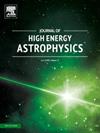Development of source-dependent gamma-ray image parameters using Generative Adversarial Network (GAN) for the MACE telescope and its implications
IF 10.5
4区 物理与天体物理
Q1 ASTRONOMY & ASTROPHYSICS
引用次数: 0
Abstract
In the field of Very High Energy (VHE) gamma-ray astronomy using the Imaging Atmospheric Cherenkov Technique (IACT), the main challenge is to elicit the faint gamma-ray signal from a huge deluge of Cosmic Ray (CR) signals. For this purpose, an extensive simulation database of γ-ray-induced extensive air shower (EAS) images across a wide energy range (30 GeV - a few 10 TeVs) must be generated. Moreover, different celestial γ-ray sources differ in flux and power-law spectral indices.
However, the position of the gamma-ray events in the image parameter hyperspace changes as per the gamma-ray source spectral profile. Hence, depending on the gamma-ray sources' spectral indices, the gamma domain cuts are subject to change. The gamma domain cuts proposed for a particular source (the Crab Nebula, for example) applied to a source of different spectral indices will inevitably result in an erroneous flux calculation of the source. The Generative Adversarial Network (GAN) is a potent unsupervised and generative Machine Learning (ML) tool to generate synthetic gamma-ray image parameters for sources with different spectral indices. This article will discuss the rationale behind developing a source-dependent database generation using the GAN and highlight its importance for the MACE telescope.
基于生成对抗网络(GAN)的MACE望远镜源相关伽马射线图像参数开发及其意义
在利用成像大气切伦科夫技术(IACT)研究甚高能(VHE)伽玛射线天文学领域,主要的挑战是从大量的宇宙射线(CR)信号中提取微弱的伽玛射线信号。为此,必须建立一个广泛的模拟数据库,模拟γ射线引起的广泛气淋(EAS)图像,其能量范围很广(30 GeV - 10 tev)。此外,不同天体γ射线源的通量和幂律谱指数也不同。然而,伽玛射线事件在图像参数超空间中的位置随伽玛射线源光谱剖面的变化而变化。因此,根据伽马射线源的光谱指数,伽马域切割可能会发生变化。针对特定源(例如蟹状星云)提出的伽玛域切割应用于不同光谱指数的源将不可避免地导致源的错误通量计算。生成式对抗网络(GAN)是一种强大的无监督和生成式机器学习(ML)工具,用于为具有不同光谱指数的源生成合成伽马射线图像参数。本文将讨论使用GAN开发源依赖数据库生成的基本原理,并强调其对MACE望远镜的重要性。
本文章由计算机程序翻译,如有差异,请以英文原文为准。
求助全文
约1分钟内获得全文
求助全文
来源期刊

Journal of High Energy Astrophysics
Earth and Planetary Sciences-Space and Planetary Science
CiteScore
9.70
自引率
5.30%
发文量
38
审稿时长
65 days
期刊介绍:
The journal welcomes manuscripts on theoretical models, simulations, and observations of highly energetic astrophysical objects both in our Galaxy and beyond. Among those, black holes at all scales, neutron stars, pulsars and their nebula, binaries, novae and supernovae, their remnants, active galaxies, and clusters are just a few examples. The journal will consider research across the whole electromagnetic spectrum, as well as research using various messengers, such as gravitational waves or neutrinos. Effects of high-energy phenomena on cosmology and star-formation, results from dedicated surveys expanding the knowledge of extreme environments, and astrophysical implications of dark matter are also welcomed topics.
 求助内容:
求助内容: 应助结果提醒方式:
应助结果提醒方式:


